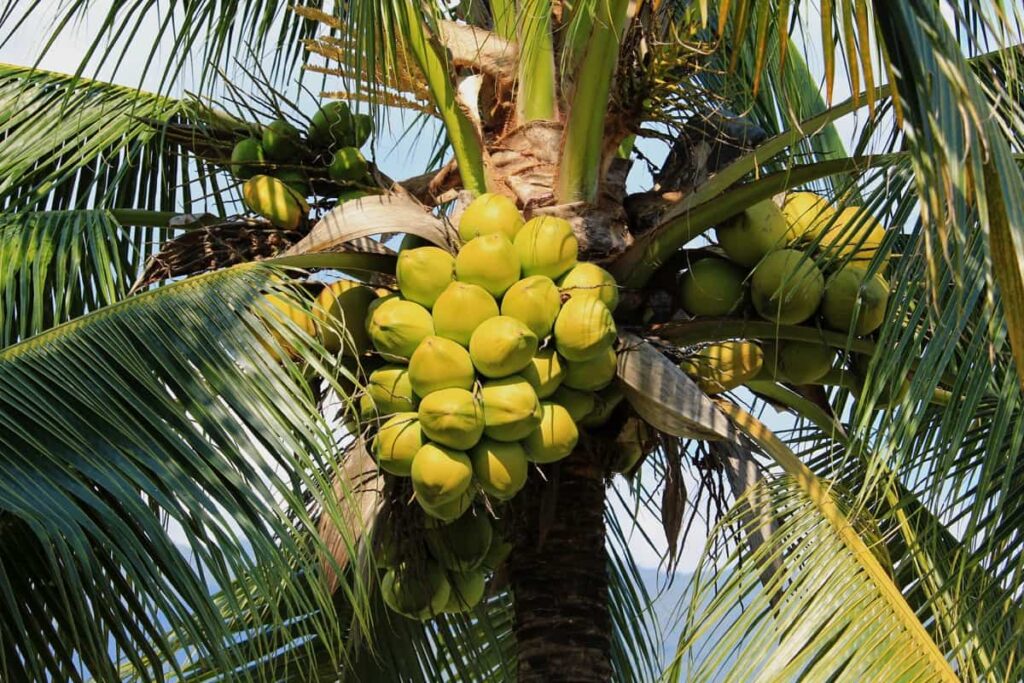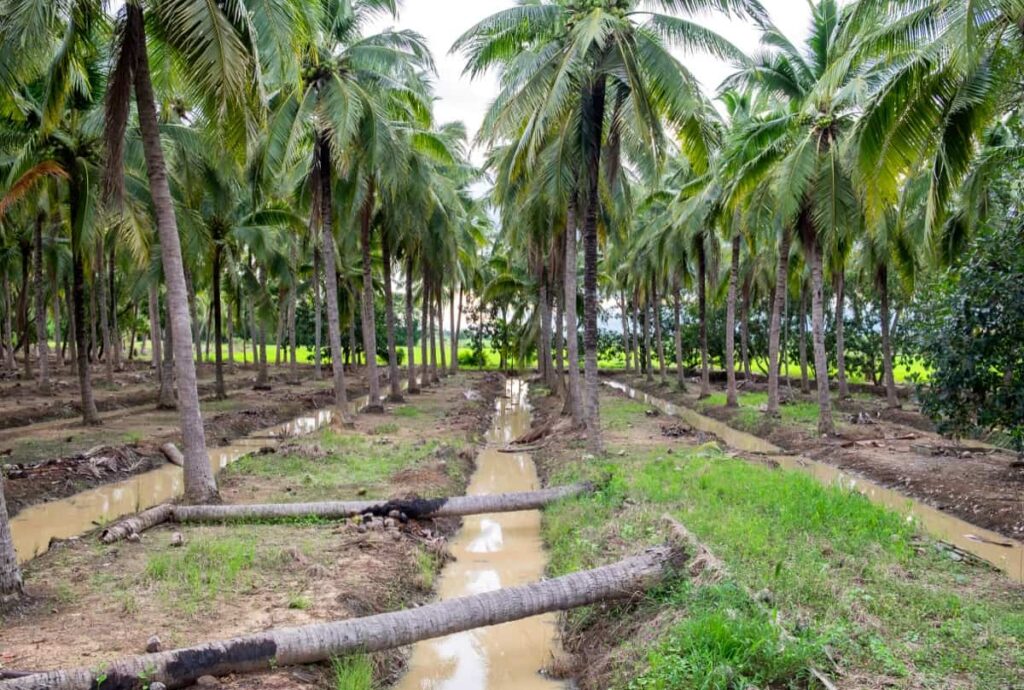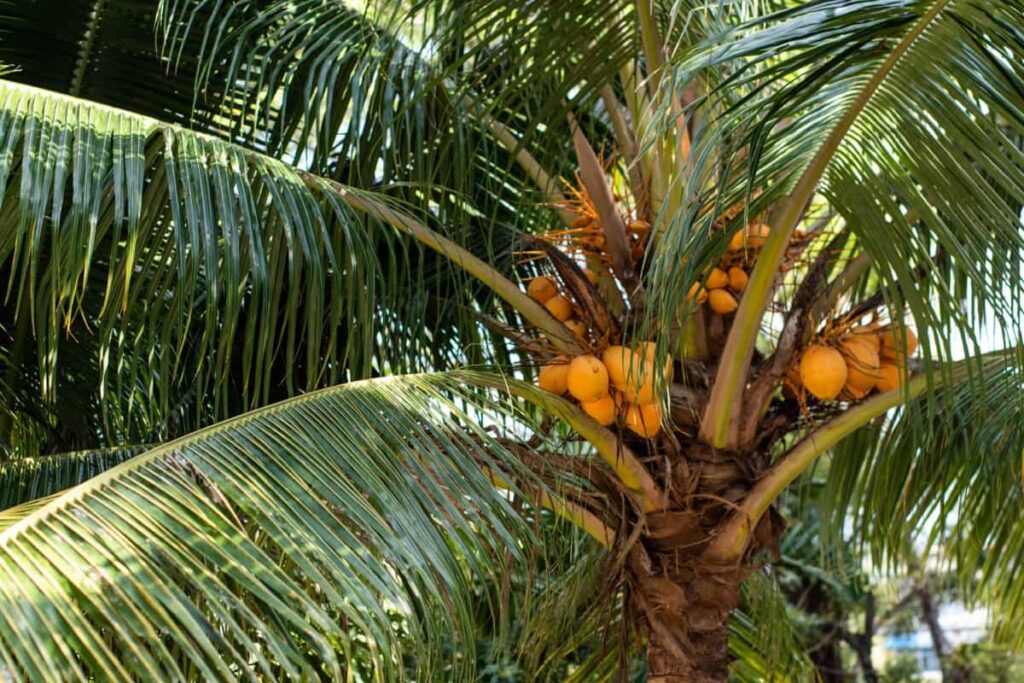Coconut orchards can be a profitable venture if managed effectively. Maximizing your yield requires careful planning and execution of operations throughout the year. This blog will provide a month-by-month guide on the essential operations for your coconut orchard. During the first months of the year, pruning and fertilization are critical to ensure healthy growth and high yields. As the year progresses, irrigation and pest management become more important, especially during the dry season.

The latter half of the year focuses on harvesting and post-harvest operations such as husking, drying, and storage. Following our month-by-month guide, you can optimize your coconut orchard’s yield and increase profitability. With proper management, coconut orchards can yield 8,000-12,000 coconuts per hectare per year, generating significant farmer income.
Coconut Orchard Operations
What is Coconut Farming and its Overview?
Coconut farming cultivates coconut trees for their valuable products, such as coconuts, coconut oil, and copra. It is an important agricultural industry in many tropical regions and provides income and employment for millions worldwide. Coconut trees require warm temperatures, abundant sunlight, and well-drained soil to thrive. They can produce fruit for up to 70 years and are relatively low maintenance compared to other crops.
The global coconut market is expected to reach USD 31.1 billion by 2027, driven by increasing demand for coconut-based products in the food, beverage, and cosmetic industries. The top coconut-producing countries are the Philippines, Indonesia, and India, with the Philippines alone accounting for almost 40% of global production.
Best Tips for Coconut Cultivation Practices
- Coconut cultivation is popular worldwide, as the plant thrives in tropical regions. To ensure a healthy crop, it is important to consider the climate and soil, cultivars and hybrids, planting material, site selection, preparation of land and planting, and care of young palms.
- The ideal temperature for coconut growth and yield is 27 ± 5°C, and a well-distributed rainfall of about 200 cm per year is optimal. Coconut cultivars are classified into two groups: tall and Dwarf.
- Tall cultivars such as West Coast Tall and East Coast Tall are extensively grown, while Dwarf x Tall (DxT) and Tall x Dwarf (TxD) are the two important hybrids.
- Proper site selection is crucial, and shallow soils with underlying hard rock, low-lying areas subject to water stagnation, and clayey soils should be avoided.
- The land must be prepared through contour terracing or bunding, and the planting system must be selected according to the soil type.
- Seedlings 9 to 12 months old with 6-8 leaves and 10-12 cm collar girth are ideal for planting.
- During the first two years after planting, the seedlings must be irrigated twice a week during the dry summer months and shaded to avoid exposure to winds. Coconut cultivation requires regular manuring from the second year of planting onwards.
- Young palms need regular manuring with a balanced fertilizer with a 4:1:3 ratio of nitrogen, phosphorus, and potassium. Proper irrigation is necessary, with a frequency depending on the soil type, climate, and growth stage.
- Inter-cultivation involves growing crops or plants between rows of young palms to control weeds, reduce soil erosion, and improve soil fertility.
- Husk burial involves burying coconut husks between the rows to enhance soil fertility and moisture retention. Green manure and cover crops, such as leguminous crops, can improve soil fertility and protect the soil from erosion.
- Intercropping with suitable crops such as bananas, pineapple, ginger, turmeric, and black pepper in a coconut garden can increase income, reduce risks, and improve soil fertility.
- Mixed farming, which involves integrating crop and livestock production, can improve soil fertility and provide additional sources of income.
In case you missed it: Eco-friendly Strategies: Sustainable Management of Coconut Pests

Importance of Month-Wise Planning for Coconut Orchard Operations
Following a well-planned schedule ensures that your trees receive adequate moisture, nutrients, and protection from pests and diseases, resulting in a healthy and productive orchard.
- Planting: Plan to plant your coconut trees during the monsoon season, which is usually between June and August. This will ensure that your young palms receive adequate moisture during their initial growth stages.
- Irrigation: During the dry season, it is important to irrigate your coconut trees regularly. Plan to water your trees every 3-4 days to keep the soil moist.
- Fertilization: Young coconut palms require regular fertilization for optimal growth and development. Plan to apply nitrogen-rich fertilizers during the first year of growth, followed by a balanced fertilizer with a 3:1:2 or 4:1:3 ratio of nitrogen, phosphorus, and potassium.
- Pest and disease control: Plan to inspect your coconut trees regularly for pests and diseases. Use appropriate measures to control these problems before they become severe.
- Harvesting: Plan your coconut harvest according to the maturity of the nuts. Coconuts are generally ready for harvesting between 11-12 months after flowering.
January Month Coconut Orchard Operations Planning
In January, planning for the proper irrigation and mulching of coconut orchards is crucial. Regular irrigation at 7 to 10-day intervals is necessary to maintain optimal soil moisture levels for young and mature coconut palms. Mulching the basins with coconut fiber or husk to conserve moisture in the soil, control weeds, and improve soil structure. Additionally, January is a good time to prune dead or diseased fronds from mature palms to promote healthy growth. It is also important to monitor for pest and disease outbreaks and take appropriate measures to control them.
In case you missed it: Optimizing Mango Orchard Operations: A Comprehensive Guide for Month-wise Planning

February Month Coconut Orchard Operations Planning
Regular irrigation every 7 to 10 days in February is crucial to maintain proper moisture levels in the soil. Additionally, weed control and fertilization should be focused on to promote coconut trees’ healthy growth and productivity.
March Month Coconut Orchard Operations Planning
March is an important month for planning operations in a coconut orchard. This is the time to apply fertilizers, which should be done at least 6 inches from the plant. Irrigating the pits immediately after using fertilizers is important to prevent nutrient loss. Additionally, one basket full of mulch material should be applied to control evapotranspiration losses and weed growth in basins. This will conserve soil moisture and prevent the development of weeds that compete with the young palms for nutrients.
April Month Coconut Orchard Operations Planning
April is an important month for coconut orchard operations planning. Regular irrigation, soil suitability testing, and soil sample collection and testing should be performed to ensure the optimal growth and development of young coconut palms.
- In addition, it is essential to check the suitability of the soil by digging a profile pit of 3 x 3 x 3 ft. and observing the presence of any calcareous nodules or sheetrock. It is recommended to avoid soils with lime nodules or sheetrock for planting. Water-logged or poorly-drained soils should also be avoided.
- Soil samples should be collected from every one-foot depth of soil from a suitable lands profile pit dug out, and the soil should be tested. Based on the soil test report, a pH of 7.0 to 8.0 is suitable for coconut plantations.
- Regular irrigation is crucial this month to ensure young coconut palms’ optimal growth and development. This can be done through drip irrigation or basins to irrigate the soil at least once in a five-day interval.
In case you missed it: Optimizing Apple Orchard Operations: A Comprehensive Guide for Month-wise Planning

May Month Coconut Orchard Operations Planning
As we move into May, coconut orchard owners must plan their operations accordingly. Tasks in May are important for coconut orchards’ long-term growth and health.
- Summer plowing with MB plow twice and leveling the land helps to prepare the soil for planting and improves soil structure.
- Alignment and peg marking for pit digging at 8X8 more. Spacing between the rows and plants (60 plants/acre) or 7.5 X7.5 mts.( 70 plants/acre) should be given. This ensures the young palms have enough space to grow and develop properly.
- Pit digging is a crucial task in May. The pit size should be 90 x 90 x 90 cm. Precautions should be taken while pit digging, including placing the dug-out topsoil (1 ½ ft.) to the right and bottom (1 ½ ft.) to the left side of the pit. Allowing the pit to expose to the sun for at least two weeks before filling the pits to control soil-borne pests and diseases.
- Arrangements for procurement of plant material from reliable nurseries, preferably from Govt. nurseries or from nurseries recommended by the Department of Horticulture.
- Ensure regular irrigation through drip or at least once in 5 days through basins irrigation. This ensures the young palms have enough water to grow and develop properly.
- Soil working to create soil mulch helps conserve soil moisture and improve soil fertility.
June Month Coconut Orchard Operations Planning
- Pit filling: Fill the pits with topsoil mixed with 25 kgs of Farm Yard Manure (FYM), 1 kg Single Super Phosphate, 1 kg Neem Cake, and 100 gm of 10% Follidol dust per pit. This will provide essential nutrients and promote healthy growth of the young palms.
- Pit filling height: Ensure the pits are filled with soil at least 6 inches above ground level. When the soil settles, it will be at the ground level at planting, essential for the young palms’ proper growth.
- Thorn fencing: To control cattle trespassing, putting up thorn fencing or any thick-growing live fence is necessary. This is important to protect the young palms from damage.
- Trench cutting: Give a mark out for trench cutting and complete the trench cutting for drip installation. Proper drip installation ensures the young palms receive the required water for their growth and development.
- Green manure and intercrops: With the onset of monsoon, farmers can sow green manure crops or intercrops. Leguminous crops like cowpea, groundnut, and pigeon pea are commonly used as green manure and intercrops. This practice helps to improve soil fertility and control weeds.
July Month Coconut Orchard Operations Planning
July is a crucial month for planning the transportation and planting of saplings. Ensuring high-quality plant material, timely irrigation, and proper planting techniques are key to a successful harvest.
- Farmers should procure high-quality plant material from selected nurseries. Select plants that have sprouted early and are growing vigorously. The plant should be at least one year old with a stout stem at the base and more leaves.
- Arrange for the transportation of the saplings from the nursery to the planting site. Keep the saplings in a trench near a water source and water them regularly until planting is done.
- If there is a delay in receiving good rains, soak the pits by giving irrigation or running the drip system.
- Take up planting the saplings in the center of the pit and water them immediately after planting.
- During the first month, irrigate the plants every 5 to 7 days and later at 8 to 10 days if there is no rain during the initial two years.
In case you missed it: Effective Strategies for Managing Insect Pests in Cabbage: A Guide for Farmers and Gardeners

August Month Coconut Orchard Operations Planning
During August month, weeding is critical to control weed growth in the orchard. Weeding should be done at least once a month during the monsoon season to prevent weeds from competing with young coconut palms for water and nutrients. It is also essential to ensure that basins around the plants are made to retain water to maintain adequate soil moisture levels.
September Month Coconut Orchard Operations Planning
To protect coconut palms from Rhinoceros beetles, black-headed caterpillars, and Red Palm Weevils, apply ten gms of Carbofuron – 3g granules to leaf whorls in September. These pests can damage young palms and stunt their growth. By burrowing into the palm trunk, rhinoceros beetles can destroy the crown. Spray Carboral 3 gms/lt or Monocrotophos on slug caterpillars before defoliating the leaves. Slug caterpillars cause damage to palm leaves, reducing photosynthesis and palm development. Coconut palms thrive best with proper pest management.
October Month Coconut Orchard Operations Planning
- Gap filling involves replacing dead or damaged plants with new ones. It helps to maintain the optimal plant density required for maximum yield.
- Planting in high rainfall zones: In areas with high rainfall, planting can be done in October-November. This helps to take advantage of the rainy season and provides adequate water for young plants.
- Inter-cropping: If inter-crop during the June-July season is not cultivated, farmers can sow inter-crops for the rabi season during this month. This helps to improve soil fertility and provides additional income for farmers.
- Rhinoceros beetle control: Farmers should observe the typical V-shaped damage of the crown leaves, which is a sign of damage caused by the Rhinoceros beetle. Control measures include hooking out the beetle from the crown and filling the holes with Linden dust and sand mixture.
In case you missed it: From Seed Selection to Successful Business: Crafting a Comprehensive Avocado Farming Business Plan

November Month Coconut Orchard Operations Planning
- Soil working in the basins and mulching: The soil in the basins of the coconut trees should be worked on and mulched with coconut, husk, or any other dry leaf matter. This helps to improve soil fertility, moisture retention, and control weeds.
- Regular irrigation: Coconut plants require regular watering, especially during the dry season. Irrigate the plants at 7-10 days intervals to ensure they receive adequate moisture.
- First top dressing: Give the first top dressing in the basin with 125 gms of urea, 250 gms of superphosphate, and 425 gms of MOP (Muriate of Potash) and irrigate immediately. This helps to provide essential nutrients to the plants, especially nitrogen, phosphorus, and potassium.
December Month Coconut Orchard Operations Planning
- Weed control: It is essential to keep the basins weed-free by hoeing and mulching the soil. Weeds compete with the coconut plant for nutrients, water, and sunlight, hindering their growth.
- Termite control: Termites can cause damage to coconut trees by feeding on the wood, leading to the weakening and eventual death of the plant. If termites are seen at the base of the trunk, they should be controlled by spraying Chloropyrephos @ 5 ml / lt.
- Red Palm Weevil Control: The red palm weevil is a significant pest that attacks coconut trees, causing severe damage to the plant. It can be identified by small circular holes on the stem with brownish viscous fluid oozing out, chewed-up fibers in the leaf axils, and toppling of the crown. Prompt removal of the dead and dying plant and root feeding with Monocrotophos 10 ml / lt of water can help control the red palm weevil.
Conclusion
Proper planning and timely execution of operations are crucial for maximizing the yield of a coconut orchard. Coconut farmers can improve their orchard’s health, productivity, and profitability by following a month-by-month guide for operations such as planting, pruning, pest control, and irrigation.
- Budget Friendly Sheep Shed Ideas: Cheap and Low-Cost Tips
- How Much Do Cattle Farmers Make: Revenue Streams in Cattle Farming
- Management Pests and Diseases in Your Cotton Field
- Sheep Farming Business Plan for Beginners
- Aquaponic Farming at Home: A Step-By-Step Guide
- Profitable Village Farming Business Ideas in 2024
- High-Yield Aquaculture: Fast-Growing Fish for Farming
- Effective Fish Pond Construction Techniques for Beginners
- Irrigation and Water Management in Pineapple Farming
- Blossom to Harvest: Mastering Flowering and Pollination in Papaya Farming
- Pig Fattening Essentials: From Selection to Sale for Beginners
- Raising Wagyu Cattle: A Complete Guide for Premium Beef Production
- Soil Types and Their Water Holding Capacity
- Optimizing Irrigation Schedules for Coconut Groves for Enhanced Yield
- Espresso Your Garden: Coffee Grounds for Healthier Acid-Loving Plants
- The Best Soil Mix for Snake Plants: How to Mix Your Own Snake Plant Soil
- Green Thumb Success: Expert Tips for Cultivating Greenhouse Beans All Year Round
- Bloom All Year Round: The Ultimate Guide to Indoor Hyacinth Care
- Eco-Friendly Gardening: How to Make Liquid Fertilizer from Kitchen Waste
- Ultimate Guide to Grow Anise in Pots: Explore Seed Propagation to Harvesting
- Guide to Raising Chester White Pigs: Discover Breed Facts to Growth Management
- Mastering the Elegance: The Ultimate Guide to Weeping Cherry Tree Care, Planting, and Maintenance
- Ultimate Guide to Planting Garlic in Grow Bags: Growing Strategies for Beginners
- How to Fix Spider Plant Leaf-Related Problems: Natural and Organic Remedies
- 10 Reasons Why Your Tulsi Plant is Shedding Leaves: Home Remedies and Solutions
- Optimizing Growth and Yield: The Advantages of Palm Bunch Ash Fertilizer
- Utilizing Neem Oil Extract as a Natural Pesticide for Hydrangea
- From Soil to Harvest: Various Ways in Which Farmers Can Use AI Tools
- Steps to Encourage and Induce Citrus Flowers: A Comprehensive Guide
- How to Fix Snake Plant Leaf-Related Issues: Natural and Organic Remedies
- Transform Your Garden into a Fragrant Oasis with Raat Ki Rani (Night Blooming Jasmine)
- Discover the Ideal Chicken Breeds for Philippine Farms
- How to Create a Poultry Egg Farm Business Plan for Profits
- Grow Lemon Cucumbers Like a Pro: Insider Techniques for Bountiful Yields
- Ultimate Guide to Caring for Your Pink Princess Philodendron: Tips for Thriving Variegation
- Areca Nut Profit Per Acre: Calculating Yield and Cost of Cultivation
